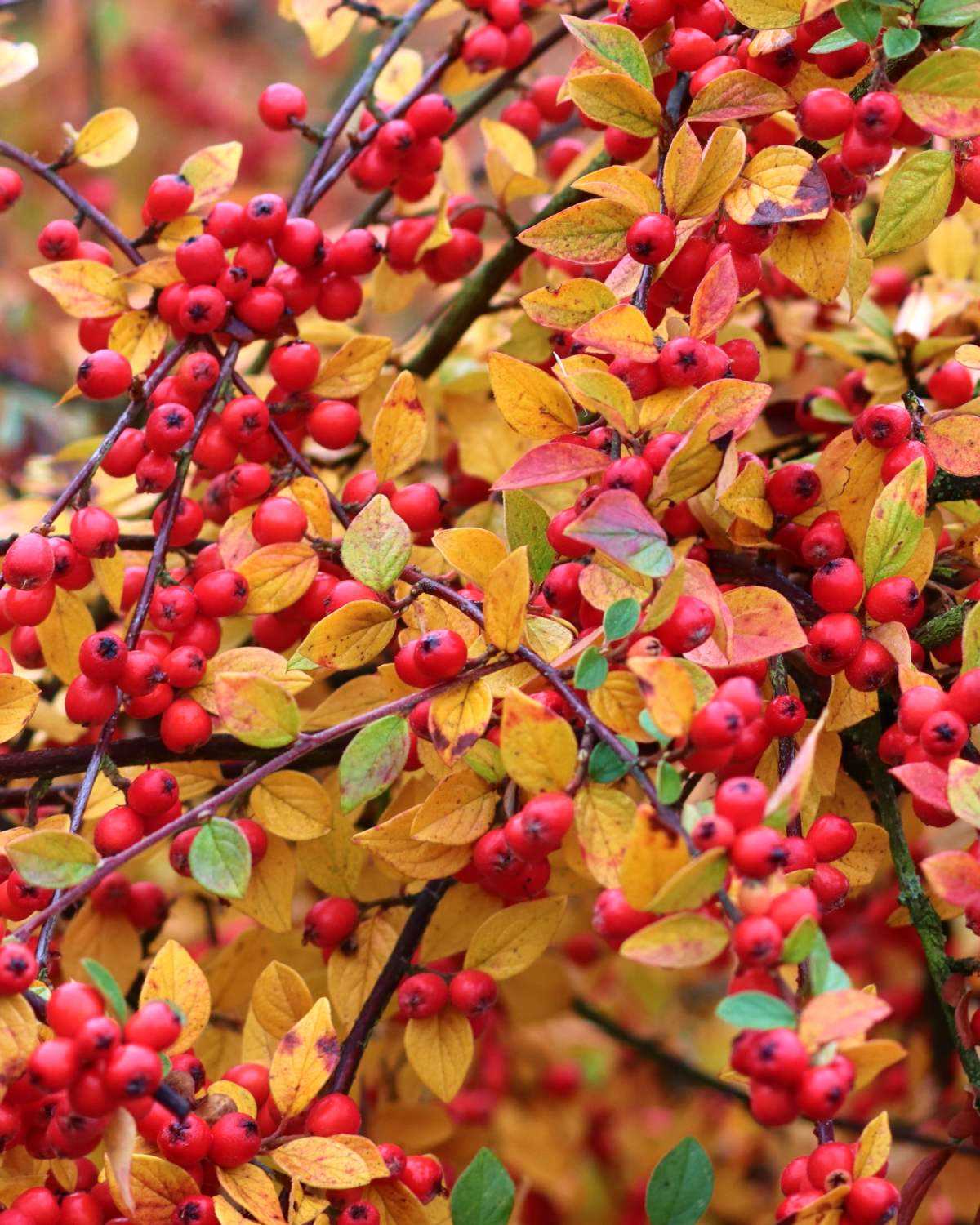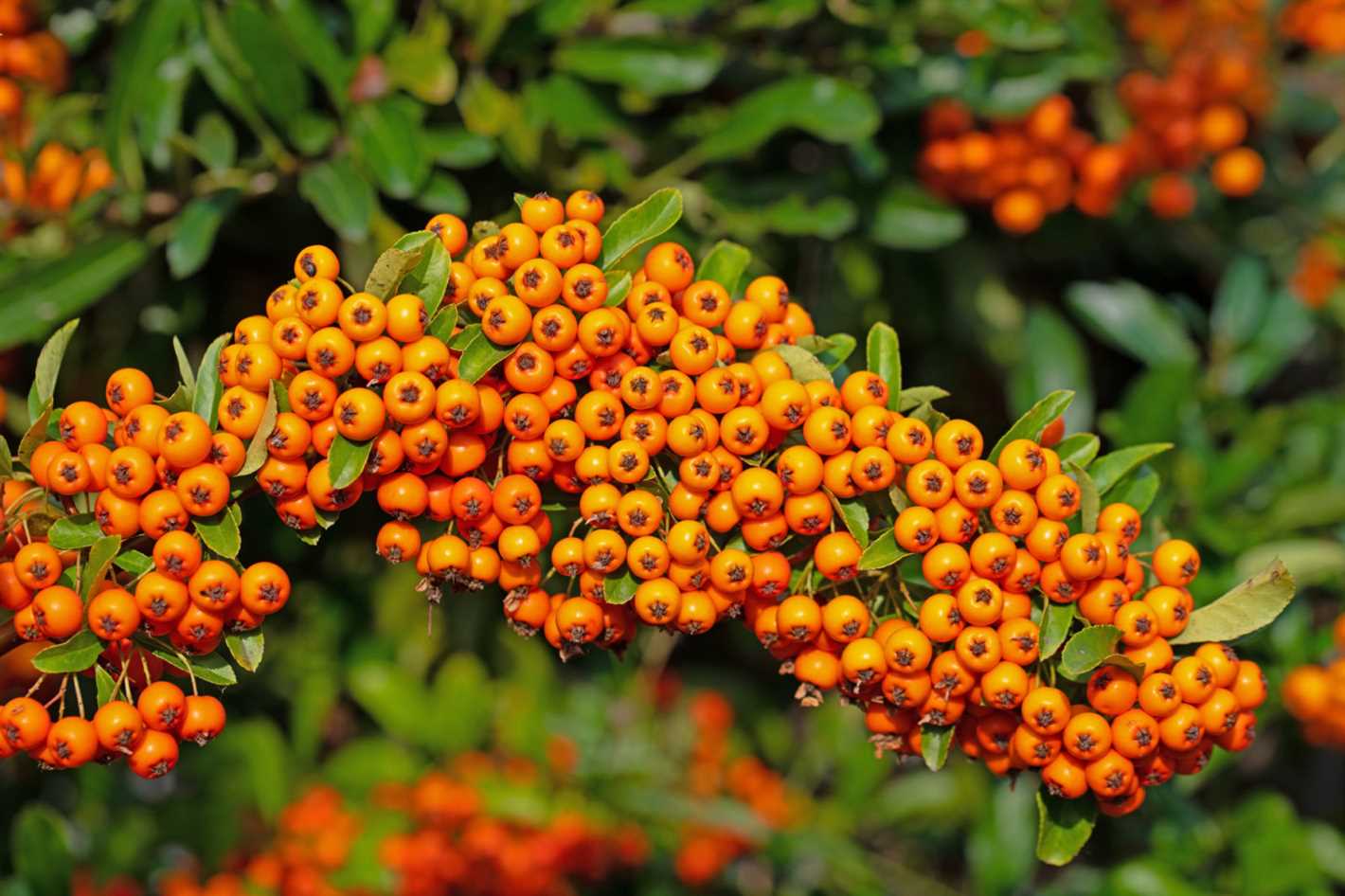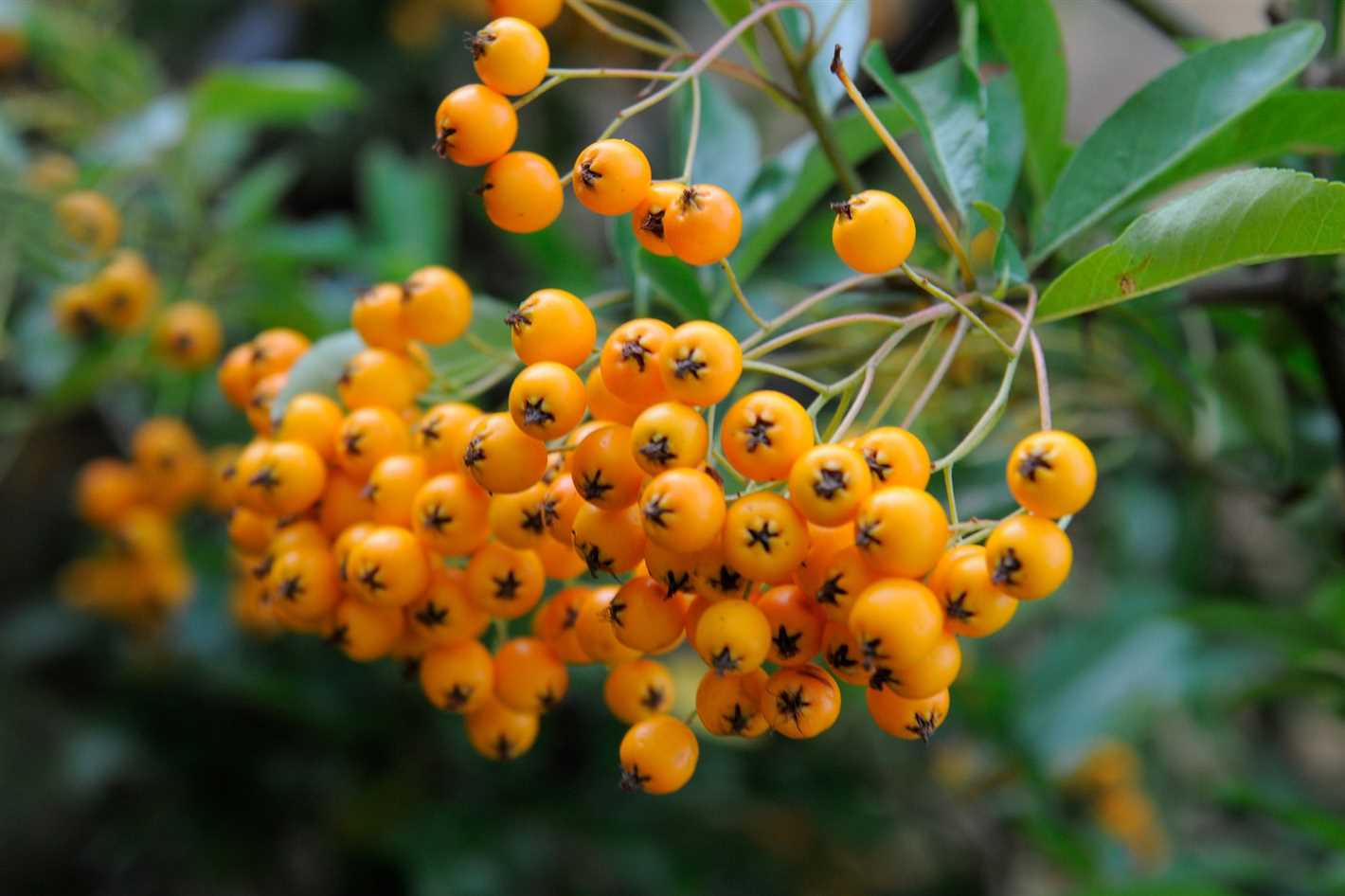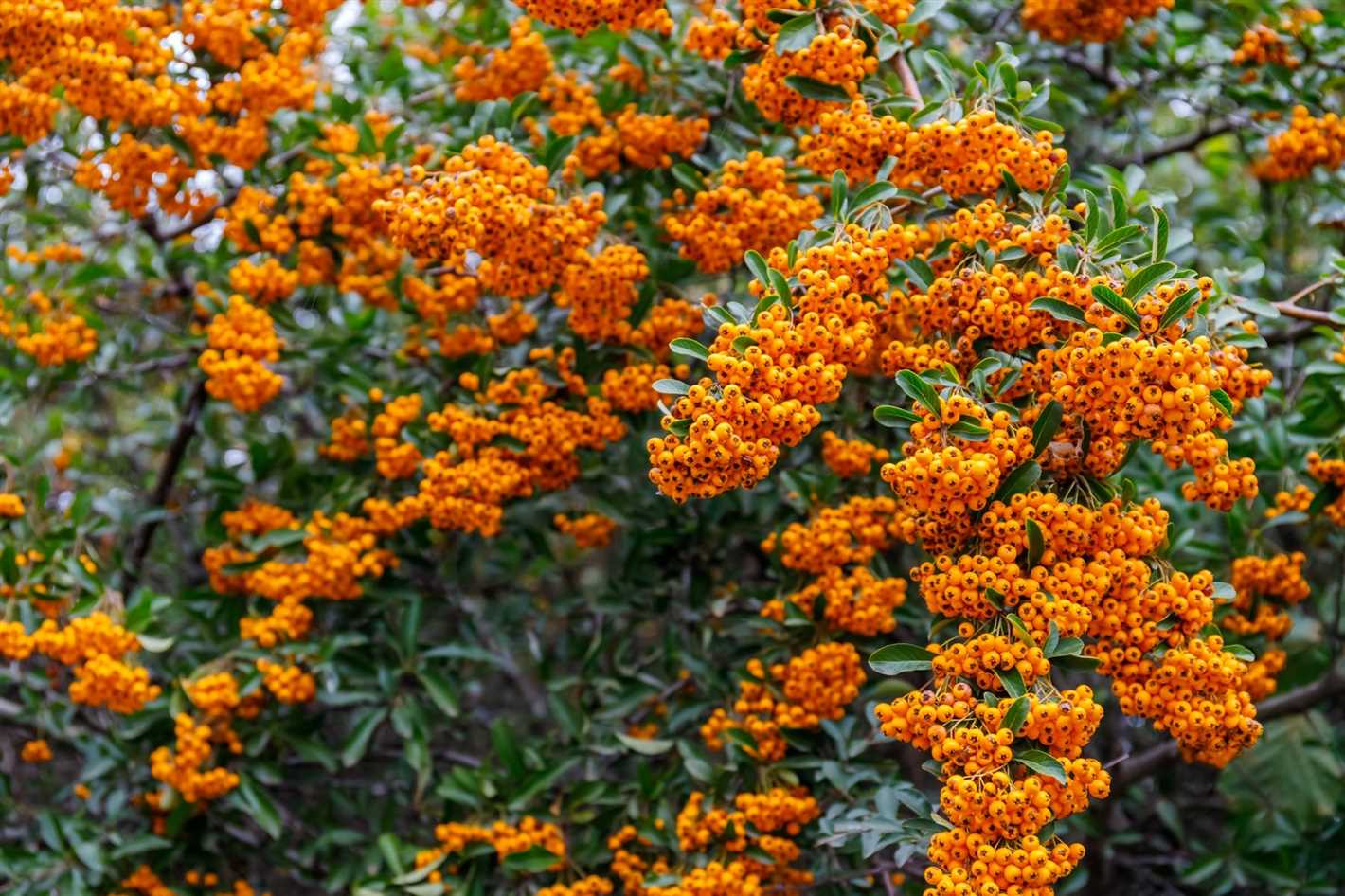- Tips for Cultivating and Caring for Pyracantha in the Garden
- 1. Planting
- 2. Watering
- 3. Pruning
- 4. Fertilizing
- 5. Pest and Disease Control
- 6. Training and Support
- 7. Mulching
- 8. Winter Protection
- 9. Harvesting Berries
- 10. Safety Precautions
- Conclusion
- Choosing the Right Variety
- Soil Preparation and Planting
- Watering and Fertilizing
- Watering
- Fertilizing
- Feeding Birds with Berries
- Pruning and Training
- 1. Pruning:
- 2. Training:
- Preventing Pests and Diseases
- 1. Aphids
- 2. Fire Blight
- 3. Scab
- 4. Spider Mites
- 5. Scale Insects
- Winter Protection
- Harvesting and Using Pyracantha Berries
- 1. Timing the Harvest
- 2. Harvesting Techniques
- 3. Using Pyracantha Berries
- 4. Storing Pyracantha Berries
- Caution:
- Additional Tips for Successful Pyracantha Cultivation
- 1. Soil Requirements
- 2. Sunlight
- 3. Watering
- 4. Pruning
- 5. Fertilizer
- 6. Pest and Disease Control
- 7. Bird Safety
- 8. Winter Protection
- 9. Propagation
- 10. Enjoying Pyracantha
- Questions and Answers:
- What is Pyracantha?
- How do I choose the right location for Pyracantha plants?
- How often should I water Pyracantha?
- How do I prune Pyracantha?
- What kind of fertilizer should I use for Pyracantha?
- What are some common pests and diseases that affect Pyracantha?
- Videos: Plant Profile – Pyracanthas

Pyracantha, also known as firethorn, is a versatile and attractive shrub that is perfect for adding a splash of color to your garden. With its abundant clusters of bright, fiery berries and glossy green leaves, pyracantha is sure to catch the eye and create a stunning visual display.
When it comes to cultivating and caring for pyracantha, there are a few things to keep in mind. First and foremost, pyracantha requires well-drained soil and plenty of sunlight to thrive. It is best to plant pyracantha in an area that receives at least six hours of direct sunlight each day.
Another important aspect of caring for pyracantha is regular pruning. Pruning not only helps to maintain the shape of the shrub, but it also encourages the growth of new shoots and improves air circulation, which can help prevent disease. It is recommended to prune pyracantha in early spring before new growth begins.
In addition to pruning, pyracantha also benefits from regular watering and fertilizing. While pyracantha is relatively drought-tolerant once established, it is important to provide adequate water, especially during hot, dry periods. Fertilizing once in the spring and again in the summer with a balanced fertilizer will help promote healthy growth and vibrant berry production.
Tips for Cultivating and Caring for Pyracantha in the Garden
1. Planting
When planting pyracantha in your garden, choose a location that receives full sun to partial shade. This shrub prefers well-drained soil and can tolerate a wide range of soil types. Before planting, ensure the soil is loose and amend it with organic matter if necessary.
Dig a hole that is wider and slightly deeper than the root ball of the pyracantha plant. Place the plant in the hole and backfill with soil, making sure to tamp it down firmly. Water thoroughly after planting to settle the soil.
2. Watering
Pyracantha plants require regular watering, especially during hot, dry periods. Water deeply to ensure the root system receives enough moisture. Avoid overwatering, as pyracantha is susceptible to root rot.
3. Pruning
Prune pyracantha in late winter or early spring before new growth begins. Remove any dead or diseased branches, as well as any crossing or crowded branches. Prune to shape the plant and encourage airflow, which helps prevent fungal diseases.
Wear protective clothing and gloves when pruning, as pyracantha has thorns that can cause injury. Dispose of pruned material carefully to prevent the spread of any diseases or pests.
4. Fertilizing
Apply a balanced fertilizer in early spring and again in early summer to promote healthy growth and abundant blooms. Use a slow-release fertilizer or a liquid fertilizer diluted according to package instructions.
Avoid applying fertilizer late in the growing season, as this can stimulate new growth that may be vulnerable to winter damage.
5. Pest and Disease Control


Pyracantha is generally resistant to pests and diseases. However, it can occasionally be affected by aphids, scale insects, and fire blight. Monitor your plants regularly and take action at the first sign of pests or disease.
Use an insecticidal soap or horticultural oil to control aphids and scale insects. If fire blight is present, prune affected branches immediately and dispose of them in sealed bags to prevent further spread.
6. Training and Support
Pyracantha can be trained against walls or fences to create a beautiful espaliered effect. Use support wires or a trellis system to guide the branches and secure them in place. Regularly tie or clip the branches to the support structure as they grow.
Train pyracantha in a fan shape or horizontally to maximize sun exposure and encourage even growth.
7. Mulching
Apply a layer of organic mulch around the base of pyracantha plants to conserve moisture, suppress weeds, and regulate soil temperature. Keep the mulch a few inches away from the trunk to prevent rot.
Refresh the mulch annually or as needed to maintain a depth of around 2-3 inches.
8. Winter Protection
In regions with cold winters, protect pyracantha from freezing temperatures by covering the base of the plant with a layer of mulch and wrapping the branches with burlap or frost cloth. This will help protect the plant from winter damage.
Continue to water the plant during winter dry spells, as extended periods of dryness can also be damaging.
9. Harvesting Berries
Pyracantha produces vibrant berries in the fall that can add color to your garden or be used for decorative purposes. Harvest the berries when they are fully ripe, which is typically after a frost or in late autumn. Use gloves to protect your hands from thorns and handle the berries with care, as they can stain.
10. Safety Precautions
When working with pyracantha, always wear gloves, long sleeves, and eye protection to protect yourself from the thorns. Take caution not to lean or brush against the shrub, as the thorns can cause injury.
If ingested, pyracantha berries can cause gastrointestinal distress in humans and pets. Keep the plant out of reach of children and pets, and ensure berries are not mistaken for edible fruit.
Conclusion
By following these tips for cultivating and caring for pyracantha in your garden, you can enjoy the beauty and benefits of this versatile and resilient shrub. With proper planting, watering, pruning, and maintenance, pyracantha can thrive and provide year-round interest in your outdoor space.
Choosing the Right Variety
Pyracantha, also known as firethorn, is a versatile plant that comes in a variety of cultivars. When choosing the right variety for your garden, consider the following factors:
- Size: Pyracantha cultivars vary in size, ranging from dwarf varieties that reach a height of 3 feet to larger varieties that can grow up to 10 feet tall. Consider the space available in your garden and choose a variety that fits well.
- Growth Habit: Some pyracantha varieties have an upright growth habit, while others have a spreading or arching habit. Think about the overall look you want to achieve in your garden and select a variety that complements your desired aesthetic.
- Flower Color: Pyracantha produces clusters of small white flowers in spring, followed by brightly colored berries in autumn. The color of the berries can range from red to orange to yellow. Consider the color scheme of your garden and choose a variety that best complements it.
- Berry Persistence: Not all pyracantha varieties have berries that persist on the plant throughout winter. Some varieties have berries that drop early, while others hold onto their berries longer. If you want to enjoy the colorful berries during the winter months, select a variety with good berry persistence.
- Thorns: Pyracantha is known for its sharp thorns, which can be a deterrent to animals and intruders. However, some varieties have more thorns than others. If you have young children, pets, or a high-traffic area, you may want to choose a variety with fewer thorns to reduce the risk of injury.
By considering these factors and selecting the right pyracantha variety, you can ensure that you have a beautiful and well-suited addition to your garden. Whether you choose a compact dwarf variety or a larger one with abundant berries, pyracantha is sure to bring color and interest to your outdoor space.
Soil Preparation and Planting
Before planting pyracantha in your garden, it is important to prepare the soil properly to ensure the plant’s success and healthy growth. Here are some tips for soil preparation and planting:
- Choose the right location: Pyracantha thrives in well-drained soil and prefers full sun or partial shade. Select a spot in your garden that receives at least 6 hours of direct sunlight each day.
- Prepare the soil: Start by removing any weeds or grass from the planting area. Loosen the soil with a garden fork or tiller to a depth of at least 12 inches. This will help improve drainage and root penetration.
- Test the soil: It is recommended to test the soil pH before planting. Pyracantha prefers slightly acidic to neutral soil with a pH between 6.0 and 7.0. You can use a soil testing kit or send a sample to a local agricultural extension service for analysis.
- Amend the soil: If the soil pH is too high or too low, you can amend it by adding organic matter such as compost or well-rotted manure. This will help balance the pH and improve soil fertility.
- Planting: Dig a hole that is twice as wide and deep as the pyracantha’s root ball. Place the plant in the hole, making sure that it sits at the same level as it was in the container. Backfill the hole with soil, firming it gently around the plant’s roots.
- Watering: After planting, thoroughly water the pyracantha to settle the soil and encourage root establishment. Keep the soil evenly moist during the first year of growth.
By following these soil preparation and planting tips, you can create a favorable environment for your pyracantha plants and promote their healthy growth in your garden.
Watering and Fertilizing
Watering
Pyracantha plants require regular watering, especially during dry periods. It is important to keep the soil consistently moist, but not soggy, as pyracantha plants do not tolerate wet feet. Water deeply, allowing the water to penetrate the root zone. Avoid watering the leaves to prevent disease. Mulching around the base of the plant can help retain moisture and prevent weeds.
Fertilizing
Pyracantha plants benefit from regular fertilization to promote healthy growth and abundant blooms. Apply a balanced fertilizer, such as a 10-10-10 or 14-14-14 formula, in early spring before new growth appears. Follow the package instructions for the appropriate application rate. Avoid overfertilizing, as excessive nutrients can result in excessive foliage growth at the expense of berries.
Additionally, pyracantha plants can benefit from an application of organic matter, such as compost or well-rotted manure, in the spring or fall. This will help improve soil fertility and structure.
Feeding Birds with Berries
Pyracantha berries are a valuable food source for birds, especially in the winter months. To encourage more berries and attract birds to your garden, avoid pruning or removing the berries until the birds have had a chance to feed on them. This will not only provide a natural food source for birds, but also add interest and beauty to your garden.
Pruning and Training
Pruning and training pyracantha plants is essential for keeping them healthy and promoting optimal growth. Here are some tips for pruning and training your pyracantha:
1. Pruning:
- Prune pyracantha plants during late winter or early spring, before new growth begins.
- Start by removing any dead, diseased or damaged branches using clean and sharp pruning shears. Cut back to healthy wood or the main stem.
- Thin out congested areas by selectively removing older stems and branches. This will improve air circulation and sunlight penetration.
- Shape the plant by cutting back long or unruly branches. Trim to the desired size and shape, keeping in mind that pyracantha can withstand heavy pruning.
- Remove any suckers or basal shoots that emerge from the base of the plant. These can weaken the main plant if left unchecked.
2. Training:
- Train pyracantha plants against a wall or support structure to create a beautiful espaliered effect.
- Start by tying the main stems horizontally to the support structure using soft garden twine. Allow side shoots to grow vertically, and tie them in as needed.
- As the plant grows, continue to train new shoots horizontally along the support structure. This will create a tidy and attractive form.
- Regularly check the ties to ensure they are not too tight, as this can damage the stems.
By regularly pruning and training your pyracantha plants, you can maintain their health and shape, while also enhancing their aesthetic appeal.
Preventing Pests and Diseases
Pyracantha plants are generally resistant to pests and diseases, but there are some common issues that can affect them. Here are some tips on how to prevent and manage pests and diseases that may attack your pyracantha plants:
1. Aphids
- Inspect your pyracantha plants regularly for aphids, which are small, soft-bodied insects that suck sap from plants.
- Use an insecticidal soap or a strong jet of water to remove aphids from the leaves and stems.
- Encourage natural predators like ladybugs and lacewings that feed on aphids.
2. Fire Blight
- Fire blight is a bacterial disease that affects the branches of pyracantha plants, causing them to turn black and wilt.
- Prune infected branches as soon as you notice the symptoms and dispose of them properly to prevent the disease from spreading.
- Disinfect your pruning tools between each cut to avoid spreading the bacteria.
3. Scab


- Scab is a fungal disease that causes dark, scaly spots on the leaves and fruits of pyracantha plants.
- Remove infected leaves and fruits as soon as possible to prevent the spread of the disease.
- Avoid overhead watering, as it can promote the development of scab. Instead, water the plants at the base.
4. Spider Mites
- Spider mites are tiny pests that feed on the undersides of pyracantha leaves, causing yellowing and webbing.
- Inspect the undersides of the leaves regularly and spray them with a strong jet of water to dislodge spider mites.
- Encourage natural predators like ladybugs and predatory mites that feed on spider mites.
5. Scale Insects
- Scale insects are small, immobile pests that attach themselves to the stems and leaves of pyracantha plants, sucking sap from them.
- Remove scale insects by hand or with a soft brush, or use an insecticidal soap to control them.
- Prune and dispose of heavily-infested branches to prevent the spread of scale insects.
By following these preventive measures and regularly inspecting your pyracantha plants, you can keep them healthy and free from pests and diseases.
Winter Protection
- Protect pyracantha plants during the winter months to ensure their survival and health.
- Wrap the base of the pyracantha plant with burlap or a frost cloth to protect it from freezing temperatures.
- Apply a layer of mulch around the base of the plant to insulate the roots and protect them from cold temperatures.
- Water the pyracantha plant regularly during the winter to prevent it from drying out.
- Protect the pyracantha from strong winds by planting it in a sheltered location or by using windbreaks.
In addition to these winter protection measures, it is also important to monitor the pyracantha for any signs of damage or disease during the winter months. Remove any dead or diseased branches to promote the plant’s overall health and prevent the spread of disease.
By providing adequate winter protection and monitoring the plant’s condition, you can ensure that your pyracantha will survive and thrive during the cold winter months.
Harvesting and Using Pyracantha Berries
When it comes to pyracantha bushes, the berries are one of the main attractions. Not only do they provide a burst of color in the garden, but they can also be harvested and used in a variety of ways. Here are some tips on how to harvest and use pyracantha berries.
1. Timing the Harvest


The ideal time to harvest pyracantha berries is in the fall, usually around September or October when the berries are fully ripe and have reached their vibrant orange, red, or yellow color. It’s important to wait until this time as unripe berries can cause stomach upset if consumed.
2. Harvesting Techniques
To harvest the pyracantha berries, simply pick them directly off the bush. It’s advisable to wear gloves as the thorns on the pyracantha bushes can be quite sharp. Gently tug on the berries to remove them from the stems, being careful not to damage the plant.
3. Using Pyracantha Berries
Pyracantha berries can be used in a variety of ways:
- Culinary uses: The berries have a tart flavor and can be used to make jelly, jam, or sauces. They can also be added to pies, tarts, or used as a flavorful garnish.
- Decorative uses: The vibrant berries can be used to create beautiful wreaths or fall arrangements. Simply thread them onto a wire or string and shape them into desired designs.
- Medicinal uses: Pyracantha berries have been used traditionally in herbal medicine for their antioxidant properties. They can be brewed into a tea or tincture and consumed for their potential health benefits.
4. Storing Pyracantha Berries
If you have harvested more pyracantha berries than you can immediately use, they can be stored in the refrigerator for up to a week. For longer-term storage, you can freeze the berries in an airtight container for several months.
Remember to always wash the berries thoroughly before using them, and to only consume them in moderation due to their tartness and potential for stomach upset.
Caution: |
|---|
While pyracantha berries are generally considered safe to consume in small quantities, some people may experience allergic reactions or digestive issues. It’s always a good idea to err on the side of caution and consult a medical professional if you have any concerns. |
Additional Tips for Successful Pyracantha Cultivation
1. Soil Requirements


Pyracantha plants prefer well-draining soil that is rich in organic matter. Before planting, it’s a good idea to amend the soil with compost or well-rotted manure to improve its fertility and drainage.
2. Sunlight
Pyracanthas thrive in full sun to partial shade. Ensure that the plants receive at least 6 hours of direct sunlight each day for optimal growth and flowering.
3. Watering
While pyracanthas are drought-tolerant once established, they do require regular watering, especially during their first year. Water deeply and evenly, making sure that the soil is moist but not waterlogged.
4. Pruning
Pyracanthas respond well to pruning and can be shaped into hedges, screens, or trained against a wall. Prune in late winter or early spring before new growth starts. Remove any dead or diseased branches and thin out the plant to improve air circulation.
5. Fertilizer
A balanced fertilizer can be applied in the spring to promote healthy growth and abundant flowering. Follow the package instructions for application rates and timing, and avoid over-fertilizing, as this can lead to excessive vegetative growth at the expense of flowers.
6. Pest and Disease Control
Pyracanthas are generally resistant to pests and diseases. However, they can occasionally be affected by aphids, scale insects, fire blight, or powdery mildew. Monitor your plants regularly and take appropriate action if you notice any signs of infestation or disease. In most cases, a strong jet of water or insecticidal soap can help control pests, while proper pruning and improving air circulation can prevent disease.
7. Bird Safety
Pyracantha berries are a favorite food source for birds, especially in winter when other food may be scarce. If you want to enjoy the sight of birds feeding on the berries, make sure to plant pyracanthas away from windows to prevent birds from flying into them.
8. Winter Protection
In colder climates, pyracanthas may require some winter protection. Mulch around the base of the plant to insulate the roots and protect them from freezing temperatures. You can also cover the plant with burlap or an old bedsheet during extreme cold snaps.
9. Propagation
Pyracanthas can be propagated from seeds, cuttings, or by layering. Collect seeds from ripe berries and sow them in a seed-starting mix in early spring. Take 4-6 inch stem cuttings from the current year’s growth in late spring or early summer, dip them in rooting hormone, and plant them in a well-draining potting mix. Layering involves bending a low-growing branch to the ground and partially burying it, allowing it to develop roots before severing it from the parent plant.
10. Enjoying Pyracantha
Pyracanthas are not only beautiful and versatile garden plants but also provide habitat and food for wildlife. Enjoy their vibrant flowers and berries, and take the time to observe the birds and insects that are attracted to them. Whether used as a focal point, a screen, or a wildlife-friendly addition to your garden, pyracanthas are sure to bring beauty and interest to your outdoor space.
Questions and Answers:
What is Pyracantha?
Pyracantha is a genus of thorny shrubs that are native to Asia and Europe. They are commonly known as firethorns, due to their fiery red berries that appear in the fall.
How do I choose the right location for Pyracantha plants?
Pyracantha plants prefer full sun but can tolerate partial shade. It’s important to choose a location with well-drained soil and good air circulation to prevent disease. Avoid planting them in low-lying areas or areas prone to frost.
How often should I water Pyracantha?
Pyracantha plants should be watered regularly during the growing season, especially during hot, dry weather. However, be careful not to overwater them, as they are susceptible to root rot. Keep the soil evenly moist, but not waterlogged.
How do I prune Pyracantha?
Pyracantha should be pruned in late winter or early spring, before new growth appears. Remove any dead or damaged branches, and thin out the interior of the plant to improve air circulation. Be sure to wear gloves, as the thorns can be sharp.
What kind of fertilizer should I use for Pyracantha?
Pyracantha plants do not usually require much fertilization, but applying a balanced slow-release fertilizer in early spring can help promote healthy growth and abundant flowering. Be sure to follow the instructions on the fertilizer package for the appropriate amount to use.
What are some common pests and diseases that affect Pyracantha?
Pyracantha plants can be prone to pests such as aphids, scale insects, and spider mites. They can also be susceptible to diseases such as fire blight and scab. Regularly inspect your plants for any signs of pests or disease, and take appropriate action, such as using insecticidal soap or pruning affected branches.







